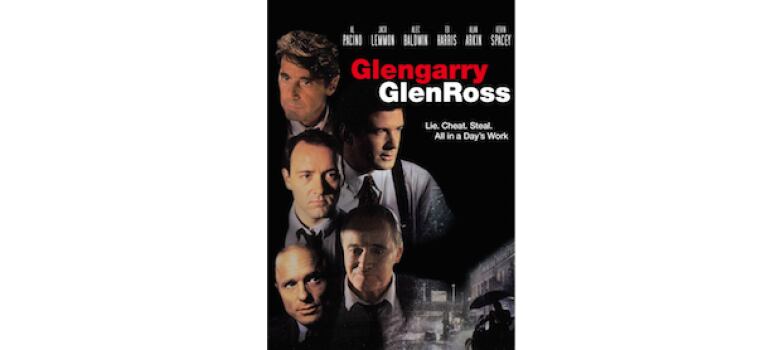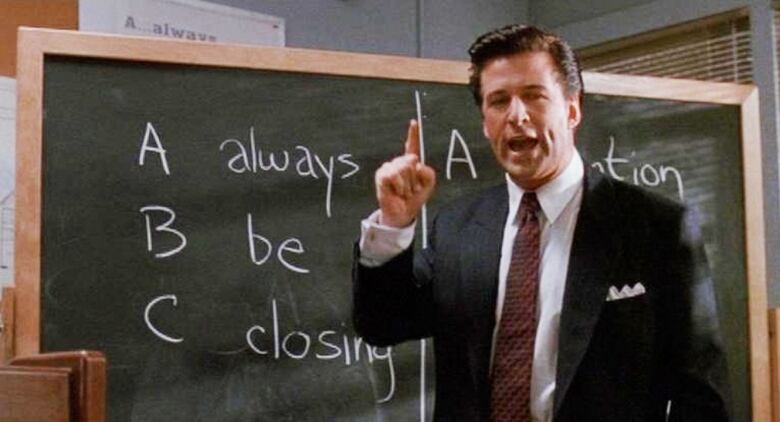Summer Series - Selling The Dream: Real Estate Advertising

*Our Summer Series airs Thursdays and Saturdays at 11:30 on CBC Radio One.*
This week, we look at the fine art of selling the dream. The world of Real Estate Marketing has its own rules, its own techniques and its own unique breed of salespeople. We'll tell the story of how the word "Realtor" was reluctantly blessed by Merriam-Webster, why so many real estate agents use photos of themselves as a marketing tactic and what happens when the real estate business tries enticing buyers using...humour.
It's a form of marketing that touches all of us and it usually involves the biggest purchase of our lives.
I've always thought the Academy Awards should have a special trophy for small roles.
Roles that are so small - or confined to one scene - that they don't even qualify for a Best Supporting Oscar.
But sometimes those tiny roles steal the film.
Like Gene Hackman in Young Frankenstein.

Or Christoper Walken in Pulp Fiction.

Or Glenn Close in Hook.

But my favourite one-scene wonder is in the film Glengarry Glen Ross.

The movie had an all-star cast that included Al Pacino, Jack Lemon, Alan Arkin, Ed Harris and Kevin Spacey.
But the most riveting scene belongs to Alec Baldwin.

The movie revolves around a real estate company. There are four agents in a gloomy outpost and they're on a losing streak.
So head office sends Alec Baldwin's character "Blake" to shake things up. Blake is the most successful real estate agent in the company, he wears an expensive suit, drives an expensive car - and he's the motivational speaker from hell:
It's an unforgettable scene because of two elements: Alec Baldwin's famous intensity, and David Mamet's incredible writing.
The movie began as a 2-act play and won the Pulitzer Prize for drama in 1984.
Yet the most quoted scene in the movie – the Blake speech – wasn't in the play.
When playwright Mamet wanted to turn his play into a movie, the script was too short. So he added material and one of those additions was this now famous 8-minute sales speech.
It's a tour de force from Alec Baldwin – as his character delivers a galvanizing message to the agents – that the real estate business may be about moving property.
But it's really all about… salesmanship.
The world of real estate marketing is a world unto itself.

It has its own rules, it has its own techniques and it has its own unique breed of salespeople.
It's a form of marketing that touches all of us and it usually involves the biggest purchase of our lives.
Real estate marketing has been around since the mid-1800s and a lot has changed. But one thing hasn't.
It's all about selling the dream.
When the Industrial Revolution spread across nations in the mid 1800s, the wealth of the world increased.

Suddenly, people were moving from the country into cities. They were no longer working farms for sustenance, but were now earning salaries at companies.
Banks then opened themselves up to "higher risk" and began granting loans to common people.
Loans begat mortgages. Mortgages allowed home ownership.
But the buying and selling of homes wasn't simple. The value of land was variable, and it was very difficult to estimate and forecast.
The transaction itself involved paperwork and large sums of money. There were few people to turn to with property experience and wisdom.
Into that void stepped something new called the real estate salesman.

With cities growing rapidly and a population hungry to own a plot of land, the pickings were easy.
That attracted a lot of charlatans to the industry. Hustlers and swindlers who would meet people at train stations as they were arriving in the big city and offer them the opportunity to buy land that often didn't exist.
Or wasn't nearly as described.
Or turned out to be swampland in Florida.
These characters became known as "land sharks." Which threw shade on the term "real estate broker."

That's when honest real estate agents decided to organize to raise the profile of their industry.
They formed boards. They wanted standards and a code of ethics.
They encouraged real estate professionals to establish offices to eliminate the problem of drift – which is to say - swindlers who had no fixed address and therefore no accountability.
As author Jeffrey Hornstein says in his superbly researched book titled A Nation of Realtors, an office with a sign was a visible manifestation of a broker's credibility.

The real estate board decided they needed a way to distinguish themselves from unethical salesmen. They thought – why not adopt a title that would designate their members and signify an endorsement by the board as qualified and responsible?
The term they settled on was "Realtor."
The word was an attempt to make the profession more respectable, along the lines of "attorney" and "physician."
While some argued that "Realtor" wasn't a real word, the real estate board defended it, saying it was short for "real estate operator." It would make Webster's Dictionary just a few years later, and would eventually be trademarked.
By 1910, the American census listed 126,000 brokers.
In Canada, the first real estate board was organized in the growing city of Vancouver in 1888. It would collapse just three months later, but was revived in 1919. In other cities, like Winnipeg, boards were established in 1903 for the same reason – to draw a line between ethical brokers and hustlers.
By 1922, the first real estate license law was established to set minimum standards of practice. But Realtor's greatest innovation was the Multiple Listing Service. By 1925, MLS was being used in over 200 cities.
As the middle class emerged, so did the real estate industry.
In the post-war years, home economists, architects, urban planners and housing officials planned, built and inspected millions of houses.
The notion of a "home" became a symbol of the ideal family unit, upward mobility and a manifestation of the Canadian and American Dream.
Real estate boards formed national associations.
A career in real estate was now seen as a legitimate profession.
In these early years, most realtors were men. As a matter of fact, the board offices were a kind of men's social club – with bars, barbershops, smoking rooms and Turkish baths.
But there was no denying that women brought a very special point-of-view to the profession.
A home was really viewed as a woman's domain.
And women knew how to find homes for other women.
As home ownership blossomed in the 1920s, so did the influx of female brokers. Even though the Depression years would drive them out again, they would come back during the Second World War.

When men went to work for the war effort or to fight overseas, women once again streamed into the real estate business. As Hornstein notes, Rosie the Riveter may be well-known, but it was Rosie the Realtor that would be the permanent legacy of the war. By 1960, 25% of realtors were women.
Today in the USA, 65% of real estate agents are women.
In Canada, it's 42%.
Real estate has also played an important role in the evolution of the advertising business.
The very first radio commercial ever broadcast was for a real estate development.
In 1922, radio station WEAF in New York sold four fifteen-second commercials to a Long Island Real Estate firm to advertise an apartment complex called Hawthorne Court. CLICK HERE to listen.
The very first advertising agency on record, was started by a real estate man named Volney Palmer.

When his Philadelphia business started to suffer during the Great Panic of 1837, he looked to expand his services in order to keep his real estate business afloat. So he began a coal supply service and advertising agency.
It was a strange pairing – but the coal business introduced him to other business people, and Palmer started booking advertising space for them in newspapers. By 1845, he abandoned real estate and the coal business and was opening advertising agencies in Boston and New York – and the advertising agency concept was born.
The 120,000 real estate agents in Canada spent approximately $625M on advertising last year, and the 1.9 million agents in the States spend approximately $13.6B.
How real estate agents advertise has always been interesting to me.
For starters, it's curious that most agents insist on putting their faces on their business cards, on their lawn signs, on billboards and in newspaper ads.

Real estate is a service business. But so are advertising practitioners, doctors and accountants, but few people would hire an advertising copywriter, a physician or an accountant based on the way they look on their business cards.
Most agents will tell you that it's all about branding.
If potential buyers and sellers see your face often enough in the neighbourhood, they assume you're successful and will give you a call. Or, that a picture is worth a thousand words. So said Confucius – who I may point out was not remembered for his picture.
But I have another theory. And I'm going to circle back to the early days of the real estate business.
I think it's about trust.
In those early days, the industry was rampant with scam artists. Con men who didn't want their pictures published. But legitimate brokers did.
That accountability meant they weren't fly-by-night operators.
I think – deep in the DNA of the real estate business – springs an ongoing desire to be respected and trusted.
In the business of trust, a face is a powerful card to play. It's about integrity.
Brokers are often the butt of jokes on that issue to this very day, as seen on the Simpson's when Marge begins working for a real estate company and her boss is explaining what "real estate truth" is:
Now, not everyone is blessed with an attractive, trustworthy face.
Three American universities collaborated on a study recently to ascertain how much physical attractiveness contributed to the success of a real estate agent.
They asked 402 people to look at photographs of agents and rate them from 1-to-10 on physical attractiveness.
Researchers then compared those results to the MLS data for each of those agents – looking at listing prices versus sales prices.
They found that agents who were rated more attractive had listings with higher selling prices and higher commissions.
The universities said the study confirmed their theory that physical attractiveness is related to productivity in the workplace and to many of the choices people make.
But here was the interesting side note: Less attractive agents had lower selling prices but more listings and more sales. Which I interpret to mean… they worked harder. Attractive people used their beauty in place of other work skills. Less attractive people simply rolled up their sleeves.
There is a realtor named Cotty Lowry who began advertising his face on a billboard in the town he lives in.

Great location. Great visibility. Great neighbourhood.
Three weeks after the billboard was put up, it was covered in graffiti. Someone drew big glasses on Lowry, a big nose and a silly moustache. So it was replaced with a new billboard. It was vandalized within a week - this time with big ears, crazy eyes and horns.

This continued over and over again.

Then the most interesting thing happened. The cycle of vandalized billboards started to make the real estate agent famous. People looked forward to the fresh graffiti. Everybody knew his name. His business flourished.

Fourteen years later, it's still working for Cotty Lowry. As a matter of fact, he was vacationing north of the Arctic Circle recently, and someone across the room recognized him from the billboards.
You never know what will work in marketing…
It's interesting that there are so many real estate companies but very few have powerful branding.
Sotheby's uses upscale blue imagery. My impression of Century 21 is based on gold jackets. But the differentiation among firms dissipates pretty quickly after that.

One interesting branding story is Remax. It has some of the most recognizable branding in the category – based on their hot air balloon.

Many years ago, two franchisees from New Mexico approached Remax with a drawing of a red, white and blue hot air balloon and said "This should be our logo."
Remax said absolutely not – a balloon has nothing to do with real estate. Hard pass.
A year later, these same two franchisees came to a regional conference with an 8mm film of a Remax balloon that had been flown the day before at a hot air balloon festival.
They said this balloon should be our logo.
So the group took a vote, and the result was a unanimous "NO."
A year after that, Remax hired a consultant to gage how well-known the company was in its hometown of Denver. The survey showed they ranked number eight. Clearly, they were in desperate need of some branding.
Then somebody remembered the Remax balloon. So they hired a plane, got some footage of the balloon floating in sky and created a TV commercial with it.
At the end of the eight-week campaign, the consultant came in with his annual survey, and told Remax they were now the number one real estate company in the city. Remax said fabulous!
Wait, the consultant said, you don't understand.
66% of the people surveyed said Remax has a red, white and blue balloon, and 36% said your theme is "Above The Crowd." After only eight weeks, this kind of feedback is unheard of. This balloon should be your logo!"
So they took another vote and the unanimous response was YES!

And that's how one of the most recognized logos in the real estate business took flight over 40 years ago.
There are some interesting ideas being used to sell houses these days.
Some homeowners, for example, have created Airbnb accounts to let qualified homebuyers spend a night in their house before making an offer.

Then there's "sign language." Here what some realtors put on signs that sold homes recently.
You know when you see a real estate sign and it has another small sign that slides into a groove on top or hangs from the bottom – usually saying "reduced price" or "by appointment only"?
Well, one recent sign like that said:

Another sign said:

Still another had a hanging sign that said:

Remember - all of these houses sold quickly.
Then there are online classified ads.
One said:

Another ad for what seemed like a very nice brand new home had a headline that said, "For the love of God, would someone buy this house?!? $415,000."
Another classified ad said: 4 bedroom, 4 bath 4400 sq. ft. hillside home. Master suite with whirlpool and deck. Open floor plan. Spectacular room to grow marijuana.
Hey, even a grow-op needs real estate services.
Then there is YouTube. And some realtors are creating some very high profile videos to brand themselves.
Meet realtor Josh Altman.
He sells the dream:
Then there's this...
Then there's ex-minister - turned real estate agent - Terry Waggonner, who prefers humour to spread his gospel:
It's pretty amusing and Waggonner's videos are worth watching on YouTube. He's one of the new wave of brokers who are choosing to zig when the rest of the real estate industry zags.
There are many nuances in the real estate game.
Ever heard of the "Ghostbusters Ruling" in real estate law?
It began with a New York legal case back in 1990.
The buyer went to court to get out of a purchase agreement because he later found out the house was haunted.
The first ruling was not in his favour. So he appealed and won.
In New York, as with many other jurisdictions, they follow the 'buyer beware' rule. The onus is on the buyer to get the house inspected for defects.
But courts ruled that an inspection would not have discovered the haunting.
So why did the court finally decide the house was haunted?
Turns out the seller actually perpetrated the rumour by reporting various spectral occurrences to the local press and to Reader's Digest over the years.
Because she had deliberately publicized that her house was haunted, she owed no less a duty to tell the buyer.
So whether the house was haunted or not was irrelevant. That the seller believed the house was haunted and had told others about her belief stigmatized the house and affected its value – and that was relevant. And the buyers weren't locals – so they had no way of knowing the history of the house.
Therefore, the court determined the house was haunted.
It's an interesting ruling. In Canada, the laws on this differ province to province. In Manitoba and Quebec, you do have to disclose if your home was the site of a gruesome homicide, for example. In Ontario, it's buyer beware.
But if you have told people its haunted, you might want to mention that so it doesn't come back to haunt you…
As Alec Baldwin's character Blake delicately states in the movie Glengarry Glen Ross, selling real estate demands salesmanship.
With 120,000 realtors, there's a lot of competition out there.
That's why a big part of a broker's job is to brand oneself. The highest profile brokers attract the most clients. And if you're not Hollywood pretty, you have to work a little harder.
Selling tools have changed. It takes more than sticking a sign in the ground today. It means utilizing social media, flying drones and even music videos.
There's a truism in marketing that the most valuable piece of real estate in the world is the corner of a customer's mind.
And in order to claim that corner, smart real estate firms should be creating memorable branding to give their agents a powerful calling card.
It goes without saying that the real estate industry is ripe for disruption. As selling tools change so do buying options, and it's only a matter of time before real estate websites move from being informational to becoming transactional.
"Make an offer" or "buy now" buttons can't be far off.
Until then, it's brokers and agents and Realtors sellin' the dream…
…when you're under the influence.